MARIANI’S
March
16, 2008
NEWSLETTER
Pasticceria in Bergamo, Italy (2007). Photo by Galina Stepanoff-Dargery
NEW! Click esquire.com
to go to my new column at Esquire Magazine.
ARCHIVE: Readers may now access
an
Archive of all past newsletters--each annotated--dating back to July,
2003, by simply clicking on www.johnmariani.com/archive
Restaurant
Index: A complete list of restaurants covered in this newsletter
since 2003. Please
click here.
SUBSCRIBE AND
UN-SUBSCRIBE: You may subscribe anyone you wish
to this newsletter--free of charge--by
clicking here.
In
This Issue
NEW YORK CORNER: Blue Hill at Stone Barns by John Mariani
NOTES FROM THE WINE CELLAR: RIGHT BANK BORDEAUX SHOWS OFF 2007 VINTAGE
by John Mariani
QUICK BYTES
PAMPLONA WITHOUT THE BULL
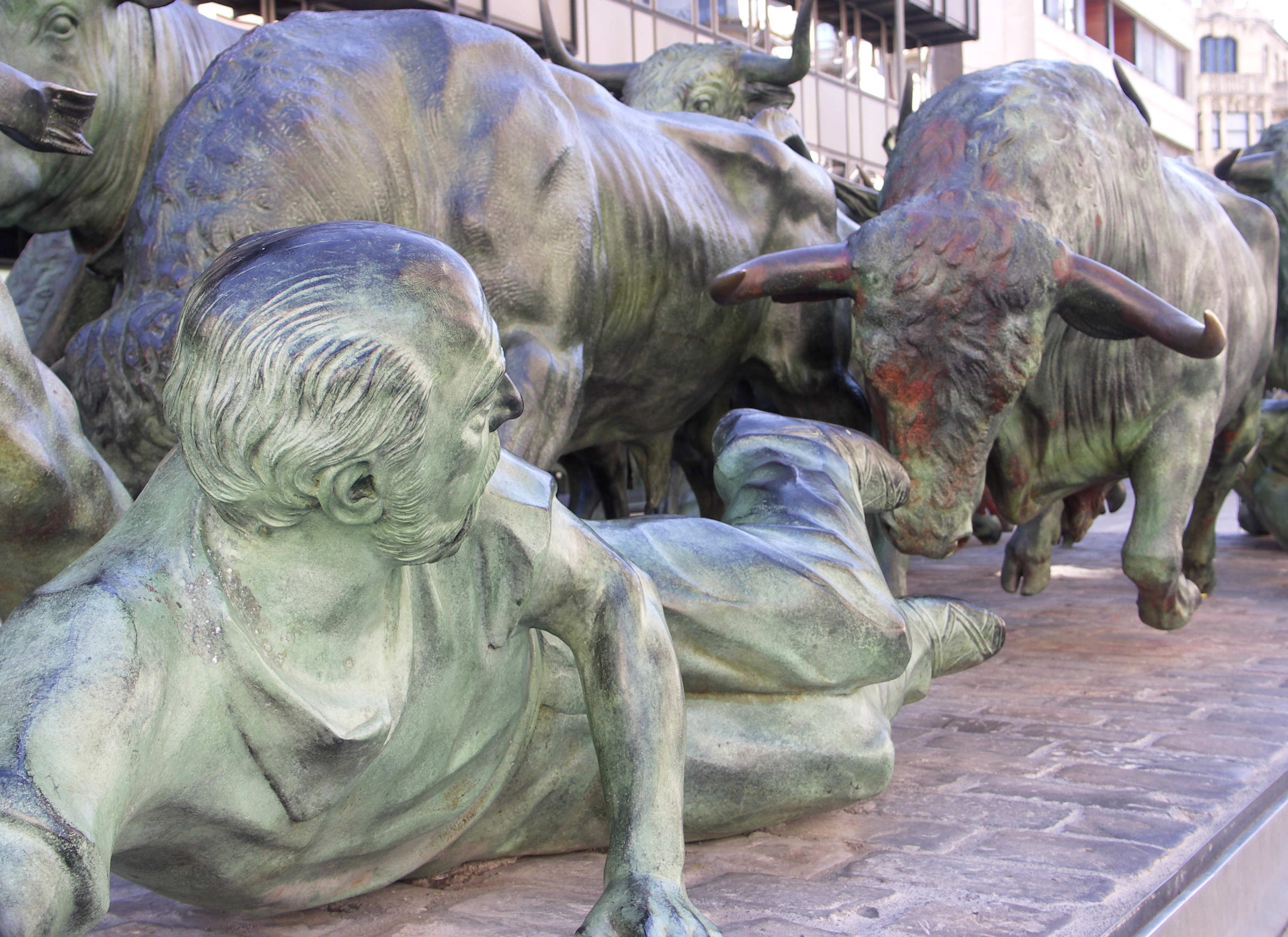
by John Mariani
Photos by Galina Stepanoff-Dargery
But for the other 355 days of the year
Pamplona is a very convivial and beautiful small city, considerably
more cosmopolitan
than when Hemingway first visited but still retaining the same charms
of historic
Navarra and northern Spanish culture, from the 14th century Gothic
cathedral to the Plaza del Toros, next to which is a street named—try
to
guess!--Paseo Hemingway. Papa certainly left his mark here.
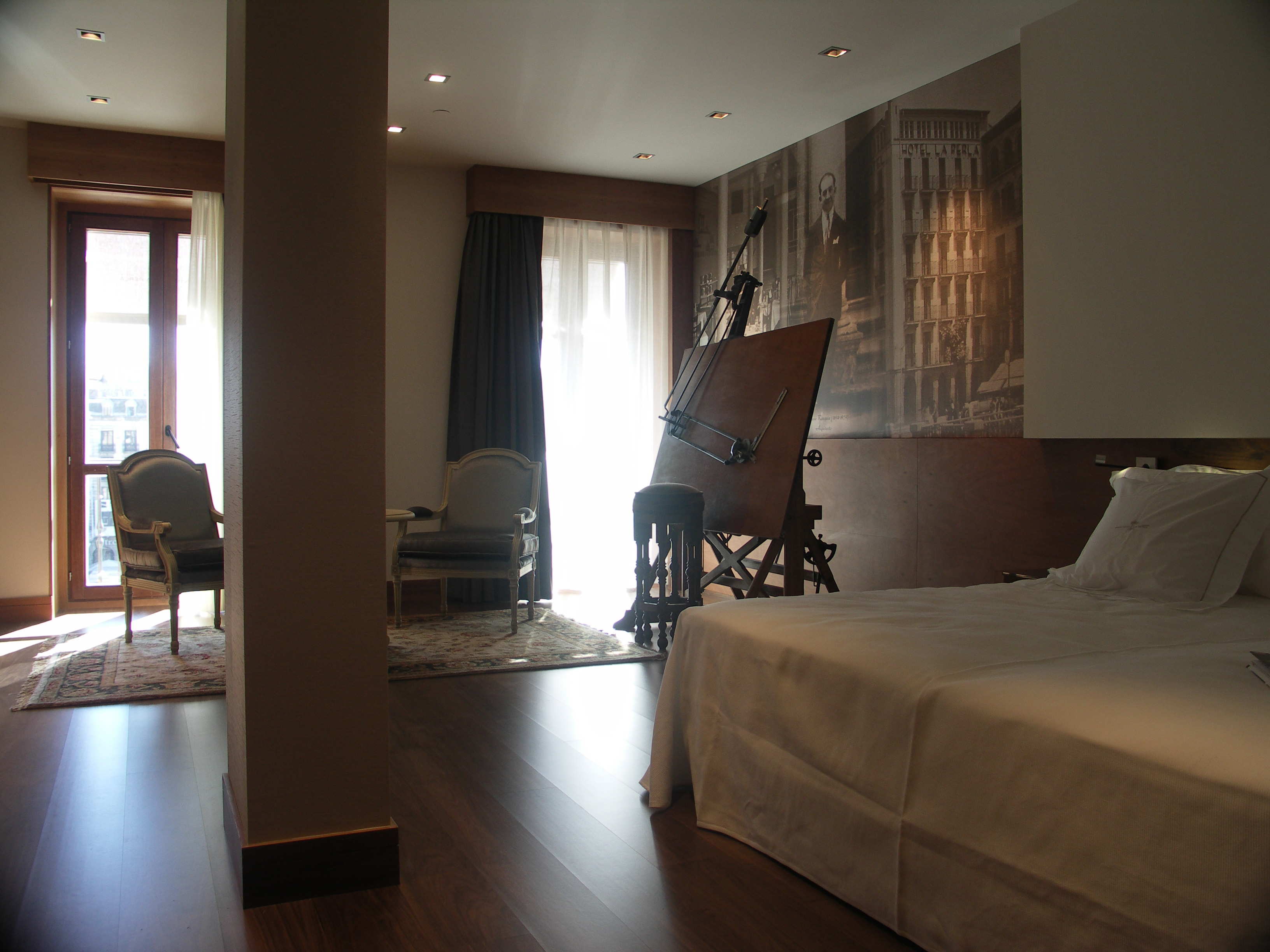 Hemingway’s favorite hotel was Gran
Hotel La Perla--in the novel called "La
Montoya"--on one corner of the broad Plaza del Castillo. His favorite
room was
No.
217, now re-numbered as 201. The hotel was just re-opened by new owners
this
past year after a complete renovation, with very modern white rooms (left) and
huge
wall photos of the days when the novelist wrote about the city. I had a room that overlooked the sun-drenched
Plaza, which is thronged with people from noon onward.
Hemingway’s favorite hotel was Gran
Hotel La Perla--in the novel called "La
Montoya"--on one corner of the broad Plaza del Castillo. His favorite
room was
No.
217, now re-numbered as 201. The hotel was just re-opened by new owners
this
past year after a complete renovation, with very modern white rooms (left) and
huge
wall photos of the days when the novelist wrote about the city. I had a room that overlooked the sun-drenched
Plaza, which is thronged with people from noon onward.
In the downstairs dining room (below) at La Perla
large windows look out onto a street where, at eight o’clock on the
mornings of
San Fermin, the bulls rumble by, not so much in pursuit of those
terrified,
white-shirted, red scarfed crazies who have come here to be chased but
in a
headlong rush to get the hell out of the streets and back to the
bullring.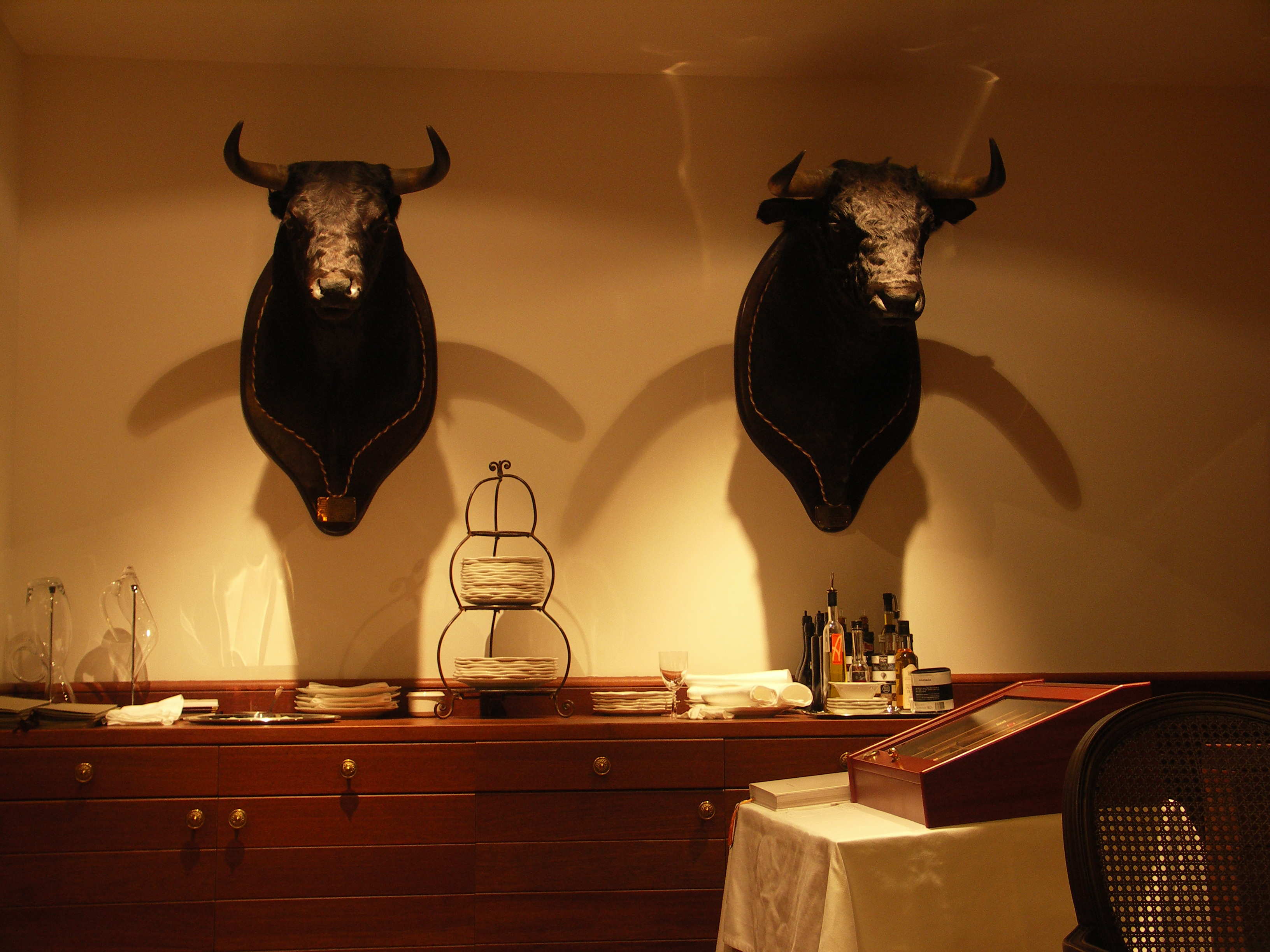
You
can actually have breakfast here at
the window and watch the spectacle over coffee and a Spanish omelet. At night the eight-table restaurant at La
Perla is one of
the best in the city, full of matador memorabilia, including two bull’s
heads, provided by matador Lalo Moreña. The hotel has here
commemorated
a famous older restaurant run by nine sisters (closed in 2000),
called the Hostel del Rey Noble.
You nibble on fried olives with a glass of cold Sherry, then move on to
piquillo
peppers stuffed with salt cod, or cut into juicy roast lamb, and drink
a Navarra wine like the deep-colored Otazu Reserva. Finish off with an
Ochoa Muscatel while enjoying the complimentary almond-lemon tuile
cookies and chocolate truffles. Dinner will run you about 35
Euros per person, without wine, but including tax and service.
The beautiful Plaza del Castillo is ringed
with cafés, including the Bar Txoko (now a completely
nondescript
tourist
haunt); 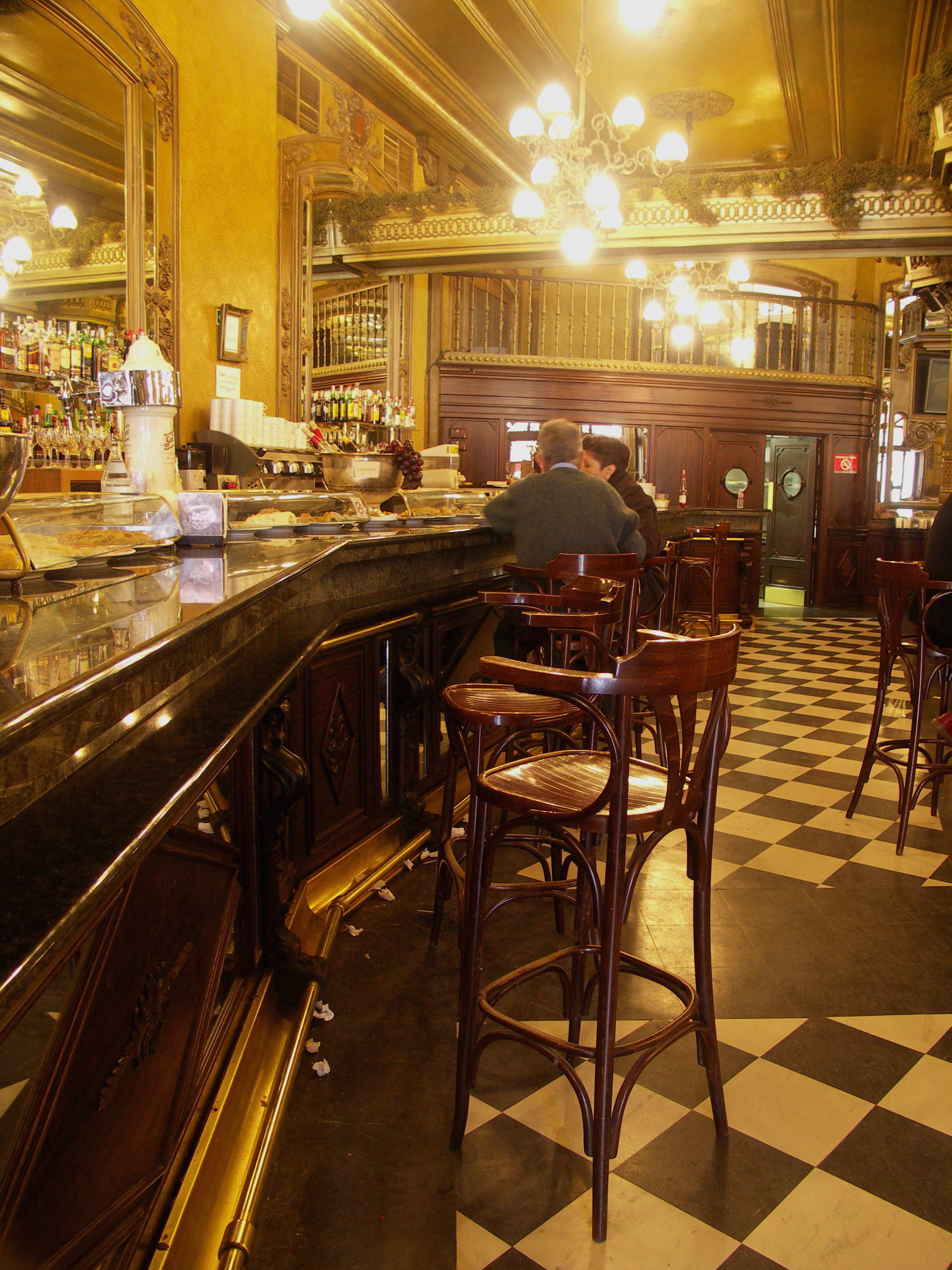 at the other end if the Café
Iruña (below),
a
very large restaurante
with art nouveau décor, simple regional cooking, and very sunny
outdoor
tables. There's
usually a wait for lunch and dinner, with many tourists on line, but
the locals make a Sunday meal here of standard Navarra fare.
(Hemingway, of course,
frequented both these places.)
The best café in town is right behind
the
dull Txoko. This is the very gregarious, always packed, clean
well-lighted
place called the Bar Gaucho on the Calle
Espoz y Mina whose tapas (here called pintxos)
have won
many awards in the region. It's a very pretty spot, with a tile
mural of seafarers, a polished bar, and well-lighted displays of both
hot and cold tapas. Also, on the street behind La Perla and off
the Plaza called Estafeta, where the bulls run, there are probably a
dozen or more tapas places, some quite obvious in their hustling for
tourists.
at the other end if the Café
Iruña (below),
a
very large restaurante
with art nouveau décor, simple regional cooking, and very sunny
outdoor
tables. There's
usually a wait for lunch and dinner, with many tourists on line, but
the locals make a Sunday meal here of standard Navarra fare.
(Hemingway, of course,
frequented both these places.)
The best café in town is right behind
the
dull Txoko. This is the very gregarious, always packed, clean
well-lighted
place called the Bar Gaucho on the Calle
Espoz y Mina whose tapas (here called pintxos)
have won
many awards in the region. It's a very pretty spot, with a tile
mural of seafarers, a polished bar, and well-lighted displays of both
hot and cold tapas. Also, on the street behind La Perla and off
the Plaza called Estafeta, where the bulls run, there are probably a
dozen or more tapas places, some quite obvious in their hustling for
tourists.
If
you’re going to the bullfights in the arena, which
start around 6:30 in the evening, tapas bars are your best bet to get
something
to eat. Afterwards, or at midday or for dinner, Casa Otano (5
Calle San
Nicolas) is a very popular, handsome, two-story rustic
restaurant in the charming Casco Viejo (old town), just off the Plaza
del
Castillo. It's been here since 1913, and has two dining rooms upstairs (below), with brick walls, stained
glass windows, wooden ceiling beams, and some pretty awful
paintings.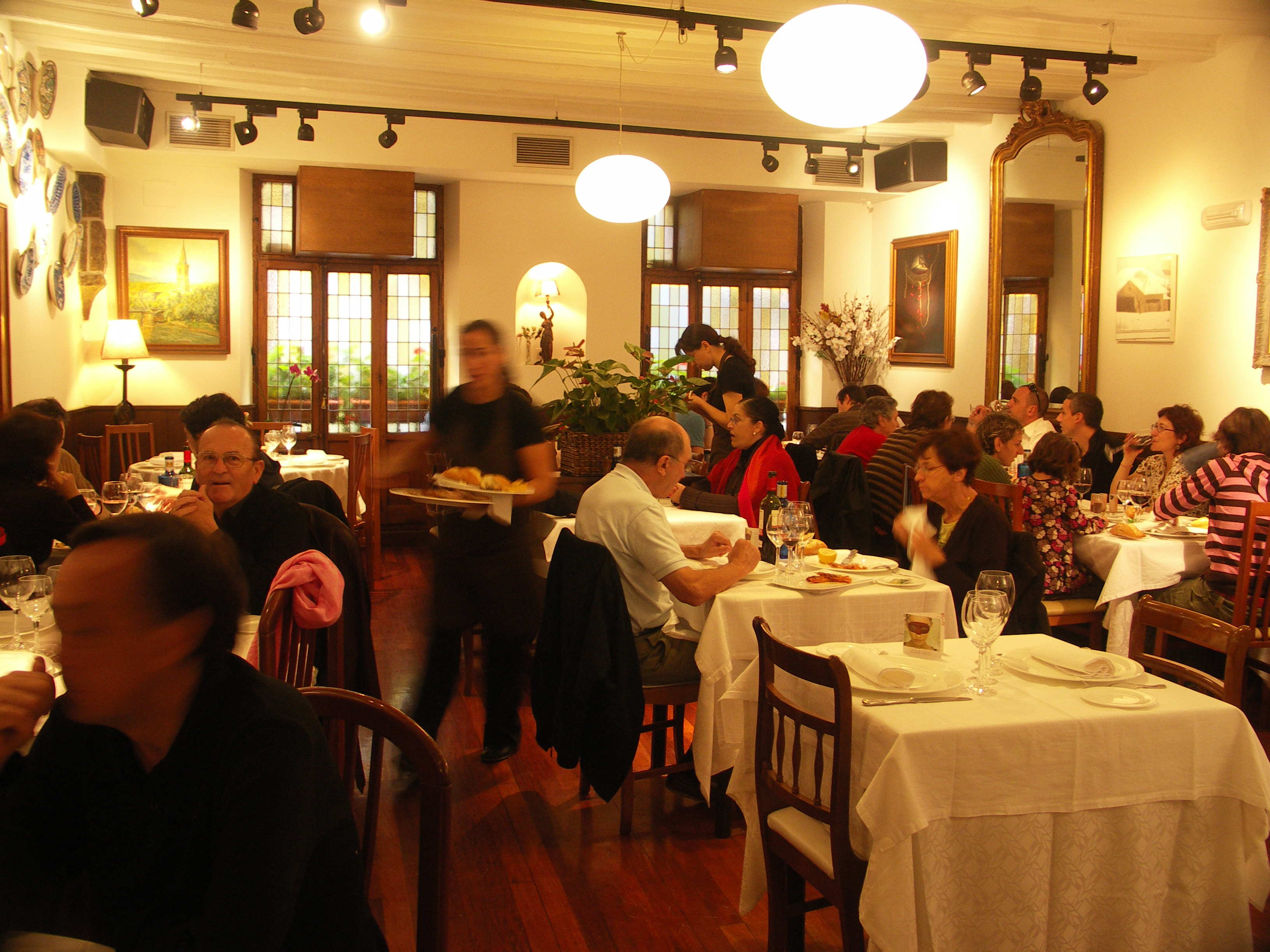 Here
you can enjoy a bowl of steaming red beans thick with carrots,
cauliflower, and
pork rind (sometimes with a few bristles still intact), and baked merluza
(hake) with a sauce of garlic and onions. Pork cheeks in red wine are
good and hearty, too, with an unexpected pear sauce. Tagliatelle with
shrimp and scallions was quite rich, a little skimpy of the shrimp,
though. For dessert have the flan drizzled with honey or the
yogurt-based cuajada soufflé
with sugar crust.
Here
you can enjoy a bowl of steaming red beans thick with carrots,
cauliflower, and
pork rind (sometimes with a few bristles still intact), and baked merluza
(hake) with a sauce of garlic and onions. Pork cheeks in red wine are
good and hearty, too, with an unexpected pear sauce. Tagliatelle with
shrimp and scallions was quite rich, a little skimpy of the shrimp,
though. For dessert have the flan drizzled with honey or the
yogurt-based cuajada soufflé
with sugar crust.
There's
a 21 Euro fixed price lunch, and at dinner figure on about 40 euros,
without wine, but including tax and tip. The winelist is pretty
thorough in Spanish and Navarra bottlings, with plenty priced under 15
Euros.
At night take your seat on the
Plaza, drink
a few Spanish brandies, and begin to
realize that life's greatest gifts to Ernest Hemingway were his
appetite and
his being born in a century that allowed him to indulge it. No one
traveled
more widely or immersed himself so deeply in the culture of a place,
picking up
the language on the street, so that he could say with certainty, "If a
man
is making up a story it will be true in proportion to the amount of
knowledge
of life that he has and how conscientious he is." And
you can sit there with your brandy and say
to yourself, yes, this is just the way Hemingway promised it would be.
NEW YORK CORNER
by John Mariani
Photos by Michael Moran
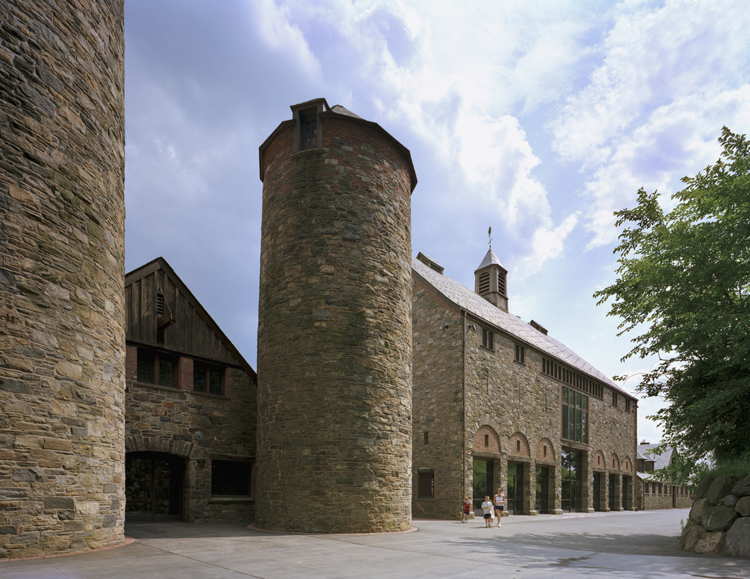
Blue Hill at Stone Barns
630 Bedford Road
Pocantico Hills, NY
914-366-9600
www.bluehillstonebarns.com
Set on 80 acres of the
Barber gathers many of his ingredients from the Center’s farm—all raised without use of chemical fertilizers, pesticides, or herbicides—along with sheep, turkeys, black pigs, and hens. Barber’s definition of “fast food” is food that came up from the farm that day, sometimes minutes before being cooked.
New York architect Asfour Guzy gutted the old barn to install the restaurant, for which British artist Ben McLaughlin painted a huge triptych evoking the land and seasons of the Hudson Valley.
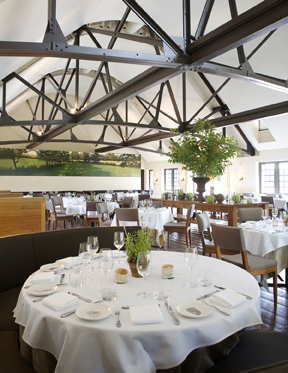
Blue Hill’s winelist, with 750 selections and 15,000 bottles is one of the finest in the U.S., overseen by sommelier Thomas Carter. It is particularly rich in small estate American labels, including New York State, many from vineyards devoted to sustainable farming. Most amazing are the scores of terrific wines priced under $50 on the list.
So why a review of Blue Hill now, four years after it opened? Because I feel that it has taken that much time to become the singularly superb restaurant I hoped it would be from the start. Back in 2004 I found the concept, the dedication, and the beauty of Blue Hill wholly admirable, but I also found the food too precious, even pretentious. Everything seemed topped with stringy, flavorless micro-greens that got stuck in your teeth. Portions were small, sauces minimal, and flavors lacked real intensity.
Now, however, after two recent visits—one at twilight in autumn, another on a cold winter’s night—I found every aspect of fine dining has come together at Blue Hills, from the perfect temperature for butter and cheeses to the hearty seasonings of the farm-made charcuterie and the crusty, yeasty breads.
You can choose anything from anywhere on the menu, categorized as “Greenhouse/Field,” “Ocean/River,” “Handmade Pasta,” and “Pasture,” or go for the 7-course “Farmer’s Feast” ($110) or the 4-course “Stone Barns Dinner” ($78). The kitchen always sends out a few amuses, like the juicy little tomato burgers with herbed goat’s cheese, or a shooter of what might be described as V-8 Juice made by a master chef.
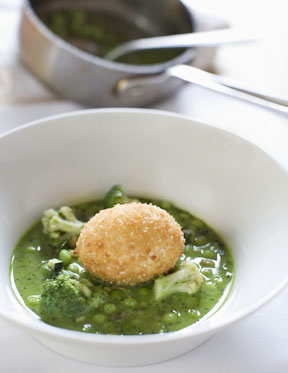 Whatever vegetables
you order, they will possess
all the tenderness and sweetness of the season. Thus, greens and herbs
plucked
that afternoon from the greenhouse come to the table with warm
mushrooms,
pistachios, and “this morning’s” soft-fried hen’s egg. Right now root
vegetables star in a beet salad with cheese torchon, walnuts, and mâche
lettuce. Cobia—not the most flavorful fish in the sea—is enhanced with
a pistou
of winter veggies and beans, while gnocchi pasta dumplings come with
local
cheeses, sweet potatoes, and chestnuts; tortellini are packed with
pumpkin purée
and dressed with hazelnuts, escarole, and shiitake mushrooms.
Whatever vegetables
you order, they will possess
all the tenderness and sweetness of the season. Thus, greens and herbs
plucked
that afternoon from the greenhouse come to the table with warm
mushrooms,
pistachios, and “this morning’s” soft-fried hen’s egg. Right now root
vegetables star in a beet salad with cheese torchon, walnuts, and mâche
lettuce. Cobia—not the most flavorful fish in the sea—is enhanced with
a pistou
of winter veggies and beans, while gnocchi pasta dumplings come with
local
cheeses, sweet potatoes, and chestnuts; tortellini are packed with
pumpkin purée
and dressed with hazelnuts, escarole, and shiitake mushrooms.Some of the best grilled Spanish mackerel I’ve had came with marinated spaghetti squash and the farm’s yogurt, while braised hake is served with winter fruit and “black dirt” spinach from Orange County.
Among the meats there is Hudson Valley venison with farro grain from faraway South Carolina. The lamb is brought in by Rabbi Bob from upstate New York, and Barber serves it with chickpeas, hummus,
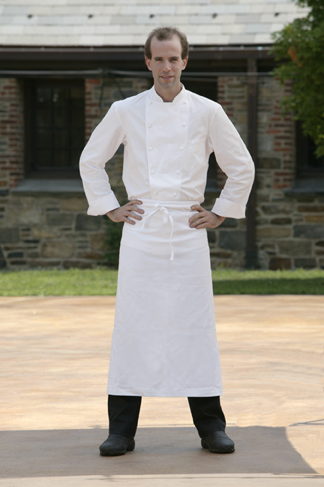 and squash. The farm’s own black pigs are the basis for
a pork dish
with smoked
ham hocks, fromage blanc
dumplings, and celery root.
and squash. The farm’s own black pigs are the basis for
a pork dish
with smoked
ham hocks, fromage blanc
dumplings, and celery root.Don’t neglect a cheese course, which may include Mrs. Quicke’s Clothbound Cheddar from Devon, England; Selles-sur-Cher from the Loire Valley, and Accapella from Petaluma, California.
And for dessert go with the chocolate bread pudding with chocolate sauce and coffee ice cream or any of the season’s fruits in items like the cranberry soufflé with yogurt sorbet. desserts.
Cooking in such a gorgeous Hudson Valley setting with access to the freshest and best ingredients allows Barber (right) and his kitchen brigade to experiment in synch with the natural order of things. Now, after four years, that synchronization is fully engaged, from farm to table, with results that make you wonder if this is what it was like in the Garden of Eden before Eve ate that apple.
Blue Hills at Stone Barns is closed Mon. & Tues.
NOTES FROM THE WINE CELLAR
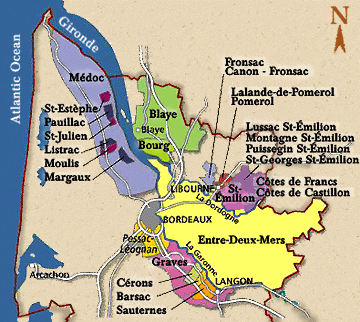 Right Bank Bordeaux Producers Give a Peek at the 2007
Vintage
Right Bank Bordeaux Producers Give a Peek at the 2007
Vintageby John Mariani
Indeed, the American antagonism towards all things French hit wineries immediately. “Before 9/11, seventy percent of our exports were to the
Only slowly have exports to the
Raynaud was in
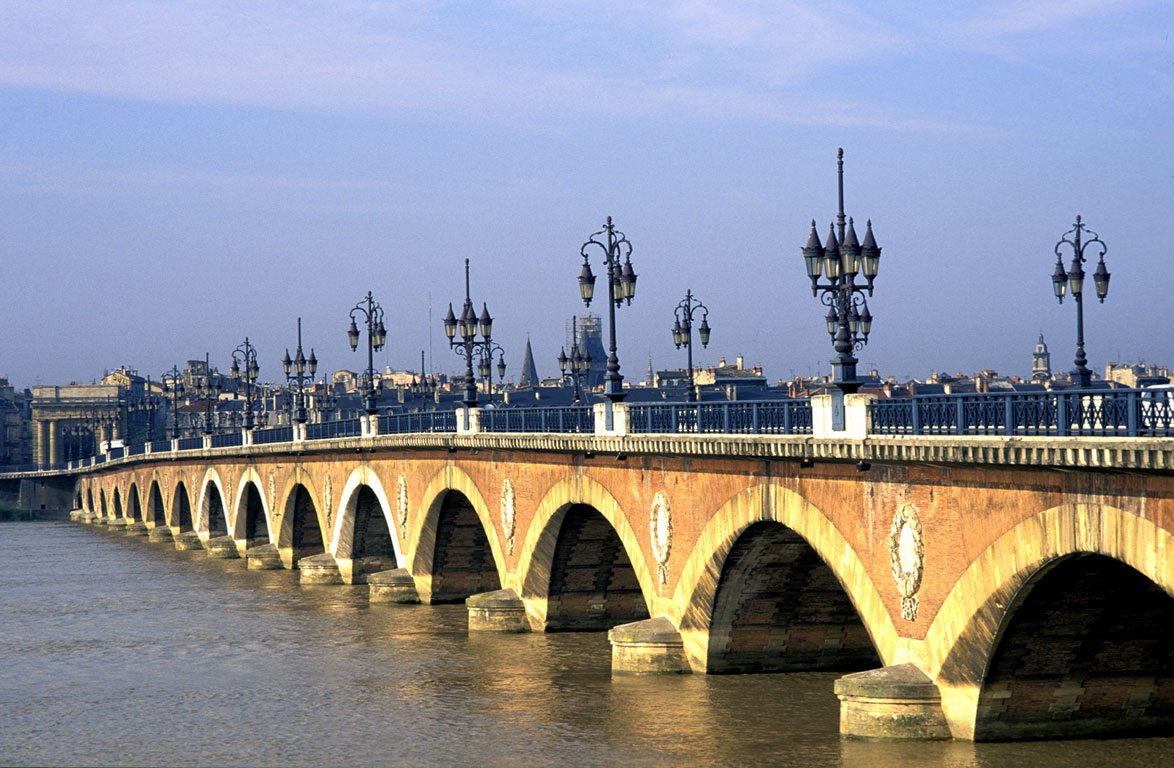
Fortunately Cercle Rive Droite producers have not suffered the dramatic slump other French wine regions have. Consistency from vintage to vintage has been the key. “Through technology we have learned how to make up for the kind of poor vintages we used to have, like 1972, 1973, and 1974,” he says. “Now, even when we have terrible weather, frost, and mildew we cannot control, we can compensate in many ways with a smaller, healthier crop. The simple training of the vines is so different than before; we remove buds and leaves and reduce the size of the crop; we don’t use screw conveyors to bruise the fruit and mix them with weeds. This all means healthier grapes, so that we can manage to make good wines even in weak years, and great wines in very good years.”
The 2007 vintage, of which I tasted about 30 examples poured for the trade and media at Chanterelle restaurant in
The topsy-turvy weather resulted in an uneven harvest in some parts of the region, but the best of the 2007s have emerged with good, soft tannins, balanced alcohol levels, and plenty of fruit flavors.
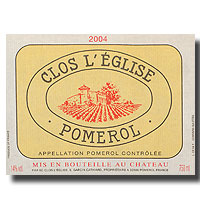 I was
particularly delighted that the taste of the various terroirs, all
dominated by
merlot in the blends, were maintained: Wines from Fronsac, like
Château Moulin
Haut Laroque, Château Dalem, and Château de La Dauphine,
were silky and had
good mineral qualities; Pomerols like Château Bonalgue, Clos du
Clocher, and
Clos l’Église were already pretty forward and promise to be
delicious
upon release; the wines from Saint-Émilion châteaux, like
Barde-Haut, Pressac, La
Rose Perrière, and Clos des Jacobins, had the characteristic
brawniness and
woody tannins of the terroir, with a powerful burst of fruit. Alcohol was for the most part kept under 14
percent.
I was
particularly delighted that the taste of the various terroirs, all
dominated by
merlot in the blends, were maintained: Wines from Fronsac, like
Château Moulin
Haut Laroque, Château Dalem, and Château de La Dauphine,
were silky and had
good mineral qualities; Pomerols like Château Bonalgue, Clos du
Clocher, and
Clos l’Église were already pretty forward and promise to be
delicious
upon release; the wines from Saint-Émilion châteaux, like
Barde-Haut, Pressac, La
Rose Perrière, and Clos des Jacobins, had the characteristic
brawniness and
woody tannins of the terroir, with a powerful burst of fruit. Alcohol was for the most part kept under 14
percent.At prices that will retail between $35 and $50, these wines should sell well, though they are in a niche of French wines for those who particularly love the subtle complexity of Right Bank Bordeaux.
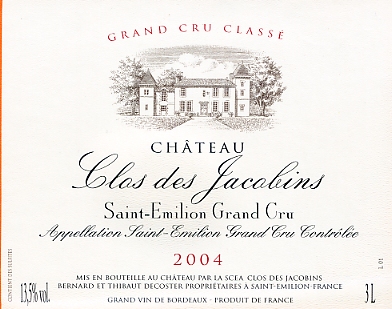
In
Cercle wines now sell 40 percent of their production in
John Mariani's weekly wine column appears in Bloomberg Muse News, from which this story was adapted. Bloomberg News covers Culture from art, books, and theater to wine, travel, and food on a daily basis, and some of its articles play of the Saturday Bloomberg Radio and TV.
JUST HOW OLD IS BOURDAIN?
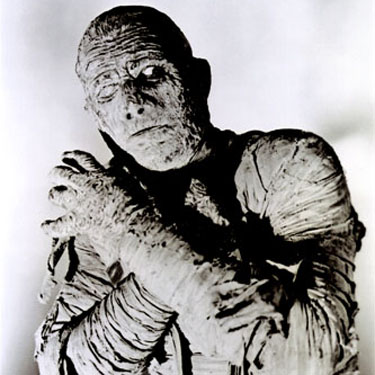
"I don't know which is worse: to be packed in a room with a lot of people half your age, in which case you feel like an idiot, or even worse, go see someone you've really loved for a long time, like Elvis Costello, and you look around and see all the other original fans and they're all old and hideous just like you. It's a totally depressing experience."—Anthony Bourdain in Fodors.com.
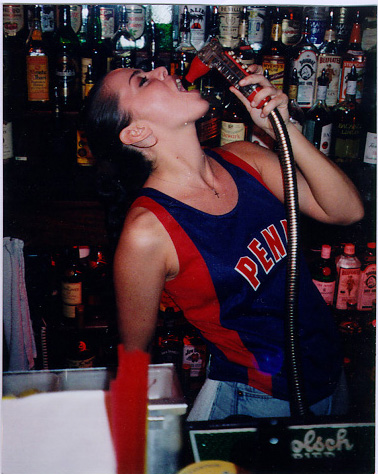
FRESHEN THAT FOR YOU, MR. KUTCHER?
According to the Wall Street Journal, actor Ashton Kutcher and wife Demi Moore celebrated his 30th birthday at the New York restaurant Socialista with Roberto Cavalli, Molly Sims, Liv Tyler, Gwyneth Paltrow, Madonna, and Bruce Willis, unaware that the woman bartender mixing up caiparinhas had apparently returned from a vacation in Honduras with a case of Hepatitis A, which, according to the NYC health Department, is spread "primarily through food or water contaminated by stool from an infected person." As a result the Health Department asked the worldwide press to spread the news, in hopes of finding all the people in attendance that night at Socialista when the bartender was working and to tell urge to get vaccinated.
QUICK BYTES
To all public relations people: Owing to the amount of press releases regarding Easter dining events, I regret that it is impossible to list any but very special events.
* From March 19-April 1, NYC's Japonica celebrates its 30th Anniversary with special fixed price menus at $65. In addition, guests will receive a complimentary glass of plum wine, and an anniversary flight of sakes will be served for an additional $10. Call 212-243-7752.
* From March 20-April 20 owner Mehanni Zebentout and Chef Jose Salgado of Nomad in NYC will feature an Algerian Wine Series with a selection of Algerian wines paired with housemade North African mezzes for $5 each and wines for $12 a bottle.
* On March 25 at Ty Warner's San Ysidro Ranch, in
* The White Barn Inn in
* From April-Dec, 2008, in Beverly Hills, CA, the Luxe Hotel Rodeo Drive is offering a 2-night “Ready for the Paparazzi Package,” with accommodations, a welcome amenity, complimentary glass of wine or cappuccino in Bar 360, dinner for two in Café Rodeo, 4 passes to Sports Club/LA -Beverly Hills, a personal hair consultation with celebrity hairstylist Jose Eber, an appointment with a personal shopper and makeup application at Saks 5th Ave. Rates start at $379 per night. Call 866-LUXE-411.
* On April 3 NYC’s Japan Society presents its annual sake tasting,”The 100-Year History of Sake” with expert John Gauntner, author of The Sake Handbook, and a rare opportunity to taste sakes debuting in Japan's spring 2008 National Sake Appraisal. Tix $35/$30. Call 212-715-1258; visit www.japansociety.org.
* On April 3 in
* From April 2-5 the Taste of Vail spring food and wine festival will feature 35 chefs, owners and sommeliers from over 50 wineries. Proceeds go to a variety of Vail Valley charities. Guest chefs incl. NYC’s Terrance Brennan of Picholine and Tony Aiazzi of Aureole, Joseph Manzare of Zuppa in San Francisco, and Curtis Lincoln of The Brown Palace Hotel in Vail. Events incl. The Après Ski Wine Tasting; The 4th Annual Colorado Lamb Cook-Off; The Mountain Top Picnic featuring a martini bar at at the scenic Eagle's Nest. And moore. Visit on Vail Mountain. Visit www.tasteofvail.com.
* On April 3 Lagunitas Brewing Company will showcase fine beers At Spenger's Fresh Fish Grotto in
Everett Potter's Travel Report:
~~~~~~~~~~~~~~~~~~~~~~~~~~~~~~~~~~~~~~~~~~~~~~~~~~~~~~~~~~~~~~~~~~~~~~~~~
MARIANI'S VIRTUAL GOURMET NEWSLETTER is published weekly. Editor/Publisher: John Mariani.
Contributing Writers: Robert Mariani,
Naomi
Kooker, Suzanne Wright, John A. Curtas, Edward Brivio, Mort
Hochstein, Brian Freedman. Contributing
Photographers: Galina Stepanoff-Dargery, Bobby Pirillo. Technical
Advisor: Gerry McLoughlin
.
Any of John Mariani's books below
may be ordered from amazon.com by clicking on the cover image.
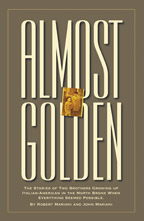 My
newest book, written with my brother Robert Mariani, is a memoir of our
years growing up in the My
newest book, written with my brother Robert Mariani, is a memoir of our
years growing up in the For those of you who don't think of the Robert and I think you'll enjoy this very personal look at our --John Mariani |
 |
 |
 |
 |
 |
 |
© copyright John Mariani 2008

